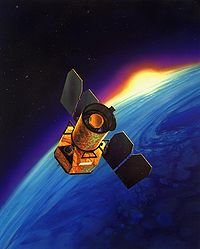GALEX
The Galaxy Evolution Explorer is an orbiting ultraviolet space telescope that was launched on April 28, 2003. A Pegasus rocket placed GALEX into a nearly circular orbit at an altitude of 697 km (432 miles) and an inclination to the Earth's equator of 29 degrees.
The first observation (called "First Light") was dedicated to the crew of the Space Shuttle Columbia and images the sky in the constellation Hercules, taken on May 21, 2003. This region was selected because it was directly overhead of the shuttle, when it had last contact with NASA Mission Control.
Science mission
During its nominal 29 month mission is making observations at ultraviolet wavelengths to measure the history of star formation in the Universe 80 percent of the way back to the Big Bang. Since scientists believe the universe is about 13 billion years old, the mission will study galaxies and stars across about 10 billion years of cosmic history.
The spacecraft's mission is to observe hundreds of thousands of galaxies, with the goal of determining how far away each galaxy is from Earth and how fast stars are forming (star formation rate, or SFR) in each galaxy. Near- and Far-UV emissions as measured by GALEX can indicate the presence of young stars, but may also originate from old stellar populations (e.g. sdB stars).
Partnering with JPL on the mission are the California Institute of Technology, Pasadena, Calif.; Orbital Sciences Corporation, Germantown, Md.; University of California, Berkeley; Yonsei University, Seoul, Korea; Johns Hopkins University, Baltimore, Md.; and Laboratoire d'Astrophysique de Marseille, France.

